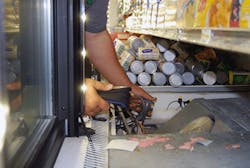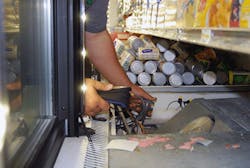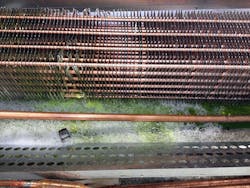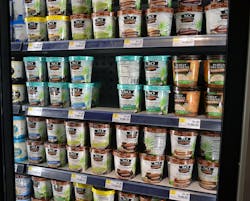Most supermarkets have a considerable number of glass door display cases. This article will focus on frozen food cases that use direct expansion evaporators, and that are connected to supermarket rack systems that use HFC refrigerants.
We will be looking at two specific problem areas, failure to maintain temperature and specific defrosting problems. With all of these suggestions, it’s assumed that the system has been designed, installed, and commissioned properly.
Start With Information
When you, the technician, get the trouble call, try to gather as much information from your dispatcher so you can, to help in your formulation of a plan on how to approach the call.
I’m a firm believer that when you are on the customer’s time, you should be focused on their problem, however, don’t let this or anything else distract you from safe driving habits.
Before you go adjusting a TXV (or any valve) make sure it needs adjusting. Remember: the TXV must have liquid and no flash gas at the inlet, and the evaporator must be approaching its operating temperature.
After you arrive, speak with the manager in the frozen food area and ask what they’ve observed about the case. You might learn that there have been recurring evaporator freeze-ups, whether the problem is affecting one case or an entire lineup, doors that aren’t closing properly, fans that are out, or many other things.
Always validate this valuable information by your own observations. Make sure power is reaching all the right places. I have seen cases where the stockers may have turned off the power while they were stocking the cases. Or they turn off case power thinking they are turning off lights. If you suspect something like this, try to get the people there to walk you through their process. Most of the time they don’t realize they are doing anything wrong.
Record SST First
To begin to zero in on the problem I like to get my saturated suction temp (SST) — this is the evaporating temperature of the refrigerant in the evaporator coil. You find this by taking the suction pressure and using a temperature pressure chart to convert it to temperature. It should be between -25F and -10F. Verify this with the case manufacture, because they can be different. If the SST is too high it’s time to determine if the suction manifold on the rack is running at the right pressure, if not, this must be corrected. If equipped, the EPR must be set at the correct pressure.
Examine the Coil and TXV
Once you’ve determined that the SST is correct, airflow is good and the fans are running, it’s time to look at the coil, I like to go to the panel where the thermostatic expansion valve (TXV) is. You should see a coil that’s evenly frosted but not blocked with ice or frost. This is an indication that the TXV is feeding properly. If the evaporator coil is partially frosted and you find a very high superheat (SH) reading, this is an indication of a starved evaporator. If all the cases on the line up are out, it could be a restricted drier, refrigerant stored in part of the system where it should not be like a heat reclaim coil, or it’s low on refrigerant. The problem must be corrected.
Before you go adjusting a TXV (or any valve) make sure it needs adjusting. Remember: the TXV must have liquid and no flash gas at the inlet, and the evaporator must be approaching its operating temperature.
The last thing you want to do is to start adjusting the TXVs. To get an accurate SH reading you must have a solid head of liquid (no flash gas) at the inlet of the TXV, and the evaporator must be approaching its operating temperature. Do not adjust the TXV open until these two criteria have been met.
If you find sporadic cases that are starved, it could be a stopped-up TXV strainer. One indicator of this is when the TXV starts frosting just past the TXV liquid inlet. Plugged strainers are from trash in the system.
TXV’s will also not feed because of moisture, this generally results in a completely blocked TXV and the evaporator coil is starved of refrigerant. If you suspect moisture as the problem, a trick that might help you verify that moisture is the culprit is to pour warm water directly on the valve. You can actually hear the refrigerant begin to flow as the moisture melts. Do not use a torch to heat the valve as this is very dangerous.
RELATED ARTICLE: Changing Dynamics in the Food Cold Chain
The TXV must have liquid and no flash gas at the inlet, and the evaporator must be approaching its operating temperature.
One of my mentors, Wes Taylor, has said that with POE lubricant, we must keep the moisture level below 50 ppm to prevent the lubricant from breaking down into soap like compounds. I can tell you from experience, that Wes is right.
For a system that holds 500 pounds of refrigerant, that’s less than two teaspoons of water. You can see how important it is to keep a clean service gauge set and hoses while using proper refrigeration practices. Systematic oil testing and drier core replacement is the best way I know to maintain a clean and dry system.
After all is said and done, you find the superheat needs to be set, for low temp cases a range of 2F to 4F is about where you should set the TXV. This is fair warning. Most TXV’s are not out of adjustment if they were set right to start with. I can’t count the number of times someone has opened the valve, and a day or two later we had to go back and readjust because the case was flooding back.
Before you go adjusting a TXV (or any valve) make sure it needs adjusting. Remember: the TXV must have liquid and no flash gas at the inlet, and the evaporator must be approaching its operating temperature.




